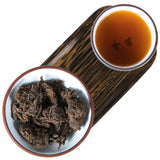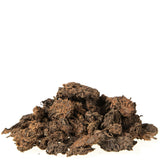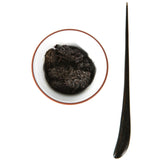The wise tea master Lao Cha once served his disciples a strange tea that looked like compressed nuggets.
– What is it, Sifu? We've never seen anything like this before! – they exclaimed
– It is "Old Tea Heads" from Bulang Mountain. This tea doesn't give in to brewing so easily, but if you are patient and learn how to open up this tea, you'll get the most delightful brew from it, full of sweetness. This tea will teach you invaluable life lessons. Now go and brew it. Proceed with patience and pay attention.
Lao Cha Tou (老茶头) means "Old Tea Heads". It's a particular type of "Cooked Pu-erh" – fermented tea common in China. It comes in the form of small lumps and is the result of agglomeration during the pile-fermentation processing of Shou Pu-erh tea. Compared with loose-leaf tea, Lao Cha Tou is richer in content and far more resistant to brewing. As a result, it releases thicker and denser tea liquor.
Our Lao Cha Tou comes from the ancient tea trees of the Bulang Mountain in Yunnan. Bulang Mountain has a reputation for its old tea trees and specific terroir. The local minority pride themselves as the first people to cultivate tea trees on these lands about 1800 years ago. This Lao Cha Tou comes from tea trees growing at an altitude of 1,600m in the ancient forests of Xishuangbanna.
During the pu-erh fermentation process, workers sprinkle water on the pile of tea leaves, leading to a fermentation process development. In this process, every once in a while, it is necessary to manually turn over the tea pile to avoid overheating the tea inside. After repeated turning, the high-quality tea leaves release juice rich in pectin and sugar. Because pectin is sticky, some tea leaves, under the pressure of weight, stick together, becoming lumps. Usually, tea farmers pick out these lumps of tea, untie them by hand, and then put them back in the tea pile. Still, some of them are too dense and break if untied. Therefore, they go into a separate pile and become the so-called "lump tea", also called "old tea heads". Generally, Lao Cha Tou accounts for 0.8~1.5% of the total production volume. Needless to say, this is a rare type of tea. This cooked pu-erh tea has undergone a clean fermentation on a wooden floor, without contact with soil.
This Lao Cha Tou will provide a balanced, medium body paired with a prominent aroma. Notes of dates and, once brewed, earth and leather will emerge during the brewing. The taste is sweet, with notes of dates and plum jam. The bright red soup is clear and transparent. We recommend "waking up" the tea with the first flush of 10 seconds or more. It will soften the tight lump and help the tea reveal its qualities. Then, you can continue with brewing as usual. While being particularly resistant to brewing, this tea is also excellent for boiling (watch the video below). We recommend simmering the Lao Cha Tou over a small fire for about 10-15 minutes after brewing to enjoy its sweet and earthy essence fully.
Watch a video on how to boil tea
![]() 212℉ / 100℃
212℉ / 100℃
 1g per 70-100ml
1g per 70-100ml ![]() 4-5min
4-5min
 1g per 20ml
1g per 20ml ![]() Rinse. 15sec + 10sec for each subsequent infusion
Rinse. 15sec + 10sec for each subsequent infusion





